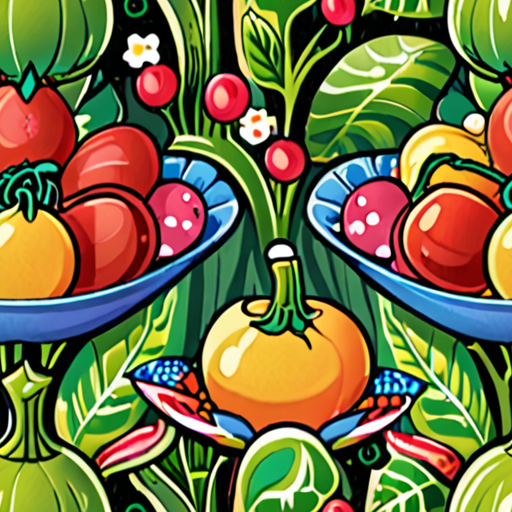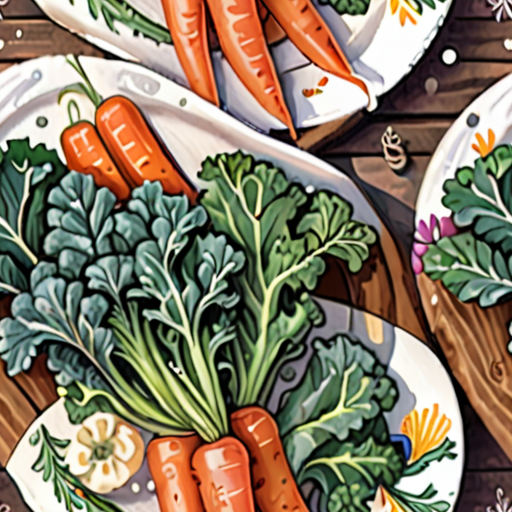As the seasons change, our palates crave fresh flavors and vibrant colors that reflect the beauty of nature. Eating with the seasons is not just a culinary trend, but a way to connect with the land, support local farmers, and enjoy the nutritional benefits of produce at its peak ripeness. In this comprehensive guide, we’ll explore the world of recipes with seasonal produce, from understanding what it means to eat seasonally to discovering delicious and healthy recipes that showcase the best of each time of year.

How to Eat Produce Seasonally
Eating produce seasonally is a great way to enjoy fresh, flavorful fruits and vegetables while supporting local farmers and reducing your carbon footprint.
- Visit Local Farmers Markets
- Check Online Resources
- Grow Your Own
- Shop at Grocery Stores That Sell Seasonal Produce
- Plan Your Meals Around What’s In Season
- Benefits of Eating Seasonally
- Fresher, more flavorful produce
- Supporting local farmers and reducing carbon emissions
- Reducing food waste and saving money
- Enjoying a wider variety of fruits and vegetables
One of the best ways to find out what’s in season is to visit your local farmers market. Talk to the farmers and ask them what’s ready to eat now and what’s coming soon. You’ll get a sense of the changing seasons and be able to plan your meals accordingly.
Websites like USDA and Local Harvest offer guides to seasonal produce by region and month. These resources can give you a head start on planning your meals and making the most of what’s available locally.
If you have the space, consider growing your own fruits and vegetables. Not only will you save money and reduce your carbon footprint, but you’ll also get to enjoy the satisfaction of eating something you grew yourself.
Many grocery stores now carry seasonal produce, often labeled as “locally grown” or “in season.” Shopping at these stores can be a convenient way to access fresh, seasonal produce without having to visit a farmers market.
When planning your meals, try to incorporate seasonal produce whenever possible. This might mean adjusting your recipe repertoire or getting creative with ingredients you already have on hand.
Eating produce seasonally has numerous benefits, including:
By incorporating seasonal produce into your diet, you’ll not only be treating your taste buds to a world of flavors, but also doing your part for the environment and your community.
What is a Seasonal Dish?
A seasonal dish is a type of cuisine that is prepared during a specific time of the year when certain ingredients are at their peak freshness and flavor.
- The concept of seasonal eating has been around for centuries, with many cultures incorporating locally sourced ingredients into their traditional dishes.
- At Memories Restaurant, we believe in embracing the changing seasons and showcasing the unique flavors and ingredients available during each time of the year.
Benefits of Seasonal Eating
Eating seasonally offers numerous benefits, including:
- Flavor and Texture:** Seasonal ingredients often have a more vibrant flavor and texture compared to out-of-season produce.
- Sustainability:** By choosing seasonal ingredients, we reduce our carbon footprint and support local farmers who use sustainable farming practices.
- Nutrition:** Seasonal produce tends to be higher in nutrients and antioxidants due to the optimal growing conditions.
Examples of Seasonal Dishes
Some popular seasonal dishes include:
- Summer:** Grilled vegetables, stone fruits, and corn on the cob are just a few examples of delicious summer treats.
- Autumn:** Hearty stews, roasted root vegetables, and warm apple cider are perfect for the cooler autumn months.
- Winter:** Comforting soups, braised meats, and roasted winter squash are great ways to warm up during the colder months.
- Spring:** Fresh salads, asparagus, and strawberries are just a few reasons why spring is a wonderful time for seasonal eating.
Cooking with Seasonal Ingredients
To get the most out of seasonal ingredients, try these cooking tips:
- Shop Local:** Visit your local farmer’s market or join a community-supported agriculture (CSA) program to access fresh, seasonal produce.
- Experiment with New Recipes:** Try new cooking techniques and recipes that showcase the unique flavors and textures of seasonal ingredients.
- Preserve the Harvest:** Learn how to preserve seasonal ingredients through canning, freezing, or dehydrating to enjoy them year-round.
Get Cooking with Memories Restaurant!
Join us at Memories Restaurant and discover the flavors and inspiration of seasonal eating. Our chefs are passionate about creating delicious dishes that highlight the best of what each season has to offer. Whether you’re a seasoned cook or just starting out, we invite you to explore the world of seasonal cuisine with us.

Is Seasonal Produce Healthier?
When it comes to choosing between seasonal and non-seasonal produce, many of us wonder whether one option is truly healthier than the other.
- The nutrient content of fruits and vegetables is typically highest when it is at its peak ripeness, which is generally when produce that is in season is picked.
- Foods that are not in season are typically flown in from other areas where they are growing better, often resulting in lower nutritional value due to longer transportation times and storage periods.
Benefits of Eating Seasonal Produce
- Higher Nutrient Content: Produce that is in season tends to have higher levels of vitamins, minerals, and antioxidants, making it a nutritious choice for those looking to boost their health.
- Increased Flavor: Seasonal produce often has a more intense flavor profile compared to out-of-season options, making it a great choice for cooking and preparing meals.
- Sustainability: Buying local and seasonal produce reduces carbon emissions associated with transportation and supports local farmers, promoting a more sustainable food system.
Why Choose Seasonal Produce?
- Support Local Farmers: By buying seasonal produce, you’re supporting local farmers who work hard to grow fresh, healthy produce for their communities.
- Save Money: Seasonal produce is often less expensive than out-of-season options, making it a budget-friendly choice for those looking to eat healthy without breaking the bank.
- Enjoy Freshness: Seasonal produce is typically harvested at the peak of freshness, ensuring that you get the best possible taste and texture in your meals.
How to Incorporate Seasonal Produce into Your Diet
- Visit Your Local Farmer’s Market: Many cities and towns have farmer’s markets where you can find fresh, seasonal produce and connect with local farmers.
- Check Out Online Resources: Websites like Local Harvest and Seasonal Food Guide offer valuable resources and inspiration for incorporating seasonal produce into your diet.
- Experiment with New Recipes: Try new recipes and cooking methods to showcase the flavors and textures of seasonal produce.

Seasonal Vegetables
At Memories Restaurant, we’re passionate about serving fresh, locally-sourced ingredients that showcase the best of what’s available during each season. Here are some of our favorite seasonal vegetables:
- Spring: Asparagus, Artichokes, Beets, Carrots, Radishes, Rhubarb, Spinach, Swiss Chard
- Summer: Bell Peppers, Cucumbers, Eggplant, Okra, Onions, Summer Squash, Tomatoes, Zucchini
- Autumn: Acorn Squash, Brussels Sprouts, Butternut Squash, Cauliflower, Kale, Leeks, Parsnips, Sweet Potatoes
- Winter: Broccoli, Cabbage, Carrots, Kale, Leeks, Parsnips, Rutabaga, Turnips
We believe that using seasonal ingredients not only ensures the freshest flavors but also supports local farmers and reduces our carbon footprint. Our chefs work closely with local suppliers to source the best produce available, often visiting farms and markets to select the perfect ingredients for our dishes.Some of our signature seasonal vegetable dishes include:
- Roasted Beet Salad with Whipped Goat Cheese and Walnuts
- Grilled Vegetable Skewers with Chimichurri Sauce
- Winter Vegetable Soup with Crusty Bread and Butter
- Stuffed Acorn Squash with Wild Rice and Mushrooms
At Memories Restaurant, we’re committed to serving delicious, seasonal cuisine that showcases the beauty of nature’s bounty. Join us for a culinary journey that celebrates the flavors and freshness of each season!
Winter Vegetables
We’re excited to share our favorite winter vegetables that are perfect for cooking during the colder months.
- Kale: A superfood packed with vitamins and antioxidants, kale is a great addition to salads, smoothies, and sautéed dishes.
- Brussels Sprouts: These tiny cabbages are bursting with flavor and can be roasted, grilled, or sautéed to perfection.
- Cauliflower: A versatile vegetable that can be used in place of grains or as a low-carb alternative, cauliflower is a great choice for winter meals.
- Carrots: Sweet and crunchy, carrots are perfect for snacking, stews, or as a side dish.
- Beets: Packed with nutrients and fiber, beets are a delicious addition to salads, soups, or as a side dish.
- Parsnips: Similar to carrots, parsnips are sweet and nutty, making them a great choice for roasting or mashing.
- Sweet Potatoes: A staple in many winter meals, sweet potatoes are high in fiber and vitamins, making them a nutritious choice.
- Leeks: Mild and oniony, leeks are a great addition to soups, stews, or as a side dish.
- Rutabaga: A cross between a cabbage and a turnip, rutabaga is a delicious and nutritious root vegetable.
- Turnips: Sweet and peppery, turnips are a great choice for roasting, boiling, or as a side dish.
At Memories Restaurant, we love incorporating these winter vegetables into our dishes to bring out the best flavors and textures.
For more recipe ideas and inspiration, visit our website at https://memories-restaurant.com/ .
Stay warm and cozy this winter with our delicious winter vegetable recipes!

Fruit Availability by Month in the USA
I’m excited to share with you the freshest fruits available in the USA by month.
-
January:
- Oranges
- Grapefruits
- Tangerines
- Kiwi
- Pomegranates
-
February:
- Strawberries
- Raspberries
- Blueberries
- Lemons
- Limes
-
March:
- Avocados
- Mangoes
- Pineapples
- Watermelon
- Cantaloupe
-
April:
- Apricots
- Plums
- Nectarines
- Peaches
- Cherries
-
May:
- Strawberries
- Rhubarb
- Asparagus
- Radishes
- Green beans
-
June:
- Stone fruits
- Blueberries
- Raspberries
- Blackberries
- Watermelon
-
July:
- Tomatoes
- Cucumbers
- Zucchini
- Okra
-
August:
- Peaches
- Pears
- Apples
- Plums
- Grapes
-
September:
- Apples
- Pears
- Quince
- Persimmons
- Fig
-
October:
- Pumpkins
- Squash
- Apples
- Pears
- Quince
-
November:
- Apples
- Pears
- Quince
- Persimmons
- Crab apples
-
December:
- Oranges
- Grapefruits
- Tangerines
- Kiwi
- Pomegranates
Now that you know what’s in season, get ready to indulge in the freshest flavors of the year!
Conclusion
With this guide, you’ll always know which fruits are at their peak ripeness and availability in the USA. Whether you’re a chef, a foodie, or just someone who loves trying new things, this information will help you make the most of the seasonal produce and enjoy the best flavors of the year.

0 Comments